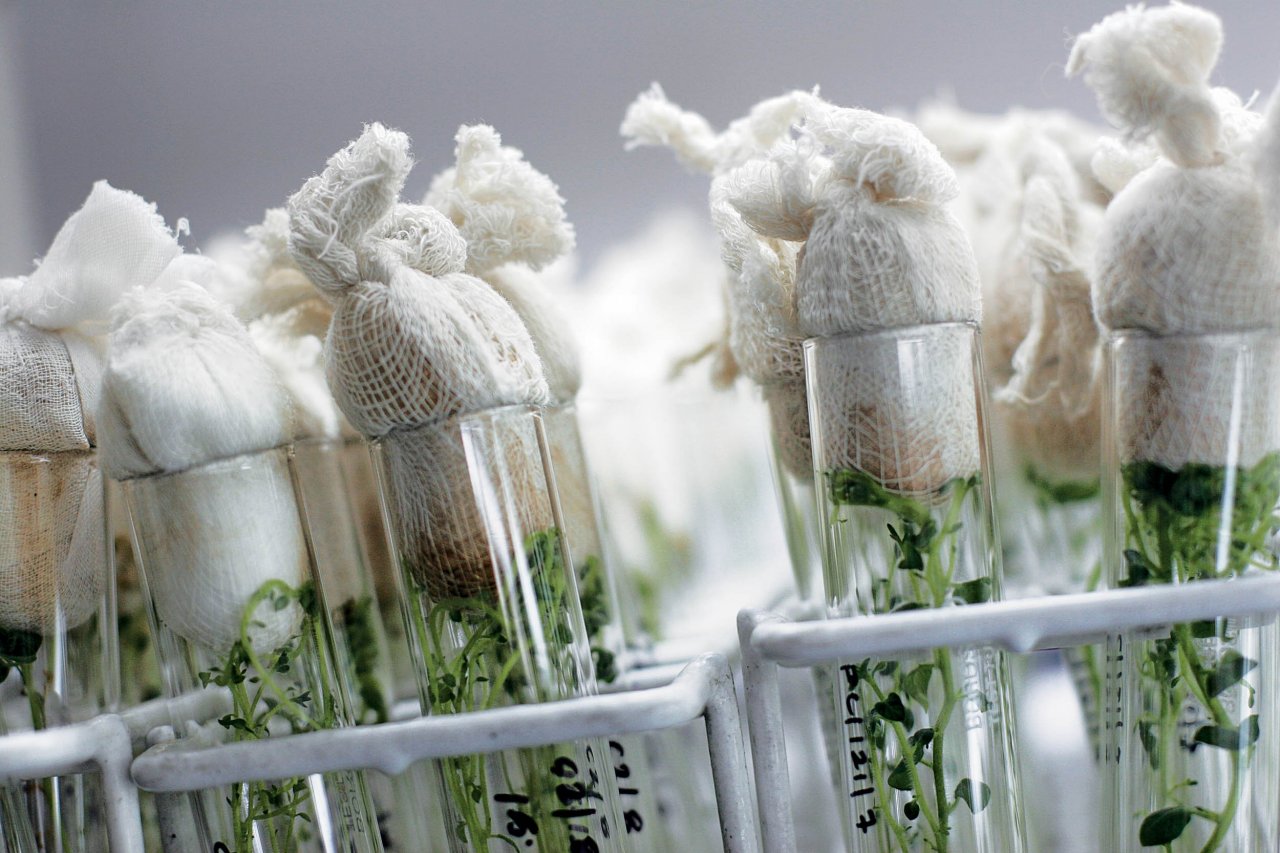A Nebraska Cornhusker frets as he surveys his drought-stunted crop. A Nigerian yam farmer digs up shrunken tubers. A Costa Rican coffee baron lays off hundreds of workers because a fungus has spoiled his harvest. I planted cherry trees in upstate New York last spring. One summer morning, they were denuded by Japanese beetles.
Such disasters are increasingly common on a planet buffeted by climate change and worldwide commerce, where heat burns crops, soil has been ruined by over-farming and drought, and bugs ride across oceans to feast on defenseless plants. Agronomists have been working on these problems for years, but the rapid population growth of humans makes overcoming these challenges increasingly urgent. If we can't feed the world, it will eventually feed on us.

The United Nations and experts say global food production will have to double by 2050, at which point the world population is expected to have grown from 7 billion today to well beyond 9 billion. That's just 35 years away, and there will be no new arable land then. In fact, there probably will be less. For example, 73 million acres of arable land in the U.S. were lost between 2002 and 2012, according to the U.S. Department of Agriculture (USDA); more was certainly made fallow during the last several years of severe drought. Looking ahead, growing conditions will only get harsher.
The solution, though, appears to be on the way: In 2012, a new tool was invented that revolutionizes how scientists can examine—and manipulate—plant genetic processes. It's called CRISPR-Cas9, and unlike its predecessors in the world of genetic modification, it is highly specific, allowing scientists to zero in on a single gene and turn it on or off, remove it or exchange it for a different gene. Early signs suggest this tool will be an F-16 jet fighter compared with the Stone Age spear of grafting, the traditional, painstaking means of breeding a new plant hybrid. Biologists and geneticists are confident it can help them build a second Green Revolution—if we'll let them.
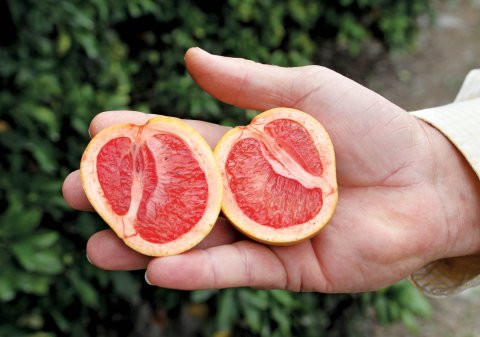
"We now have a very easy, very fast and very efficient technique for rewriting the genome," said one of its inventors, Jennifer Doudna of the University of California, Berkeley, when the Innovative Genomics Initiative was launched in 2014. "[It] allows us to do experiments that have been impossible before." The speed and simplicity of CRISPR have momentous implications for agriculture: The process could lead to plants that can withstand what an increasingly overheated nature has in store. It could also result in a more nutritious yield, from less plant. Researchers have glommed on to it—they've already published more than 150 related scientific papers, and the publication rate is accelerating. "It's tough to keep up with all the papers that are coming out," says Joyce Van Eck, who runs a lab focused on the study of genetics-based crop improvement at Cornell University's Boyce Thompson Institute. "The field is exploding."
Pull on DNA's Zipper
CRISPR stands for—brace yourself—Clustered Regularly Interspaced Short Palindromic Repeats. The name comes from a trick that bacteria use to protect themselves from lethal viruses and phages, little cellular saboteurs. The "palindromic repeats" (gene sequences that read the same from either end) are immune response elements, genetic code the bacteria copy and incorporate from invading viruses so that, if they return, they can be easily identified. It's a bit like posting an FBI wanted poster or splashing enemy soldiers with glow-in-the-dark paint.
The technique requires two accomplices: molecules called guide RNA and a protein from a class labeled Cas. The most effective one found so far is Cas9. RNA has long been known to be the vehicle DNA needs to convey its message. In a cell, Cas9 prepares the chemical environment around a DNA molecule for interaction, then spurs RNA to find the selected section of DNA. Once it does, the RNA will guide the Cas9 into the DNA, where the Cas9 unzips DNA's double helix and does one of three things, depending on the chemical instructions scientists provide: It blunts this section's ability to work, stimulates it to go to work or excises selected genes. Then the cell's repair crew zips the DNA back up.
The process can easily modify plant DNA without changing the plant's essence—except to make it tastier, more nutritious, quicker to market, easier to ship, machine-pickable, less needy of water and/or able to flourish in a heat wave. And we can do it for big companies and small, the world at large and isolated communities.
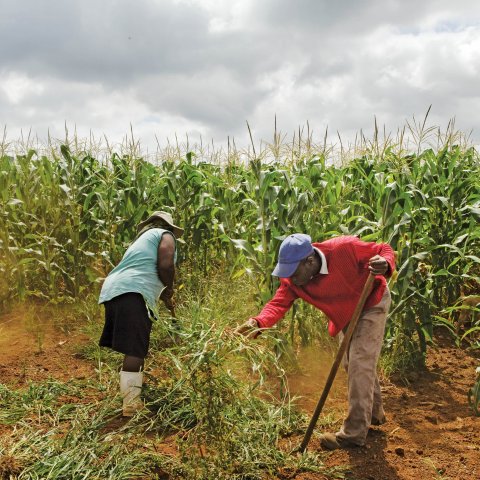
In the old days, relying on hit-or-miss natural processes to breed plants took many years. Norman Borlaug, father of the first Green Revolution—a hugely successful effort to improve food-crop productivity in poor countries that began in the 1940s and eventually doubled or even quadrupled what many plants could produce—needed almost two decades to create a better wheat variety. With CRISPR-Cas9, we can compress that development cycle to a few days or weeks.
This is partly because we can now process, store and compare vast quantities of genetic data quickly and cheaply. The upshot for scientists has been the rapid growth in knowledge of cell chemistry and genes, and most important, our ballooning database of many species' genomes.
Ideally, we would know everything about the genome of all our favorite produce staples, down to the placement of every single gene. And this cataloging is happening with astonishing speed. Researchers at Kansas State University have sequenced the first and toughest of wheat's 20 chromosomes—and that one chromosome is far more complex than the entire rice genome. They say they'll be able to do the next 19 in three years. The result will be complete knowledge of the genome of the world's third-most cultivated crop, the one with the most protein and arguably the grain that is most versatile as a food and cooking source.
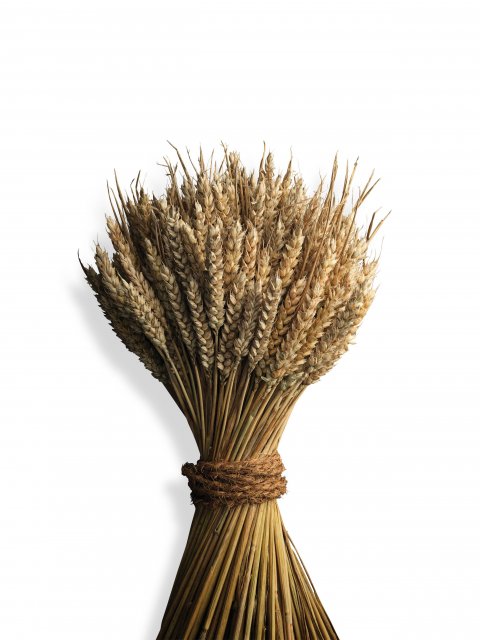
Then, the amazing flexibility of CRISPR-Cas9 can be brought to bear. The idea is to use the process to replace a segment of a plant's genetic sequence entirely, a bit like exchanging a chunk of Lego blocks, to improve specific plant behavior. Imagine a wheat strain that thrives at the edge of a salt marsh in tropical Ecuador. Compared with Iowa's amber waves of grain, it's a runt that produces small, bitter kernels. But by adding bits of the Ecuadorian genome to the American variety, scientists make a strain that is more salt-tolerant and still provides a big yield. Both dry, salty Ecuador and dry, salty America would gain a better plant.
It's critical to note this has nothing to do with creating a new species. CRISPR-Cas9 is a tool that helps us adapt plants to new environments by fine-tuning their own genetic traits, using their own genes from plants they'd naturally breed with, such as their wild versions. As the tool targets a tiny segment of a plant's DNA, the plant stays the same species—technically, even the same genotype. As scientists see it, the technology respects a plant species for its evolutionary capacity to thrive over eons, while helping it evolve more quickly to adjust to today's environment. We are only putting our foot to the accelerator of natural plant processes.
Beautiful Tomatoes
Caution and guidelines are certainly called for. The early results of CRISPR-Cas9 tests have not been completely predictable. A published number is up to an 80 percent success rate, high for experimental stuff but not high enough for commercial applications. What can happen is "off-target DNA interactions," where "you accidentally modify a very similar sequence elsewhere in the genome," says Cornell's Van Eck. This was also a big problem in earlier genetic engineering technologies, which basically flooded a plant's genome with compounds, trusting that some would stick. CRISPR-Cas9 is comparatively precise, but some scientists remain cautious. The technology could and probably will get better; different versions of CRISPR-Cas9 could be developed, or scientists could find a new enzyme that does what CRISPR-Cas9 does more precisely.

On the other hand, Van Eck and her colleagues have proved that what they already have works beautifully with the tomato, a plant that's become "a model species, like the white rat in animal studies," she says. Soon she and others in the field will be working to improve the tomato's hardiness and disease resistance, with results that will come with what she terms "drummer-like precision"—the exactitude of, say, Elvin Jones or Charlie Watts—"because we can go in and target exactly the areas we want." Other early advances include a new version of rice that is more adaptable and has the ability to photosynthesize faster and more efficiently. That portends a future where, thanks to CRISPR-Cas9, scientists are at the rice control console, able to consider the available inputs—water, soil nutrients, temperature—and make adjustments to better control the outputs: productivity, nutritional value, resilience. All that's needed is for consumers to buy in.
Suspicions Trump Science
Biotech crops are already well-established around the world. The U.S. has approved about 100 genetically modified plants for use in agriculture. Virtually all cotton in India, a vital economic staple for the country, is GM, as is 90 percent of cotton grown in China. Four out of every five harvested soybeans on earth are genetically modified. Corn worldwide is 35 percent genetically modified. Bangladesh is considering a GM eggplant that could double its harvest by protecting it from worms. Food writer Mark Bittman recently pointed out that we've been happily eating harmless genetically modified, virus-resistant papayas for years, and that's Mr. Natural talking.
But some countries are balking. Mexico, where maize was first domesticated, must now import it to meet local demand because activists there will not allow genetically modified organism hybrids. Mexico's maize growers get yields 38 percent lower than the world average and three times below the U.S., where 90 percent of the maize crop is an insect-resistant GMO hybrid. Mexico's fields are beset by such crop ravishers as the corn earworm, black cutworm and fall armyworm, which cost the country up to half its crops and incite farmers to spray their land with thousands of tons of chemical insecticides.
The European Union has approved just one genetically modified crop, a type of maize used for animal feed. The reasons are political and bureaucratic: A majority of member countries must approve a biotech plant, and anti-GMO sentiment runs strong in places where phrases like naturel and natürliche are more about what's been done for centuries than what it actually means for something to exist in or be caused by nature.
This genetic work has not just found detractors but also aroused fierce partisans. Take Golden Rice, for example. It's basic rice, but modified to produce its own vitamin A, potentially saving up to 2.8 million children a year from blindness and a million of them from death. Yet it sits in labs, unused. The notion of GMOs has spooked environmental groups such as Greenpeace, which has resisted GMOs with violent action, including destroying an experimental Golden Rice field last year in the Philippines. This despite the fact that Golden Rice is being offered to the world by a nonprofit, with no commercial stipulations, and is likely to save many lives.
The scientific consensus for the safety of GMOs is overwhelming. A recent Pew poll found that 88 percent of U.S. scientists think GMO technology is harmless. By contrast, only 33 percent of civilians agreed. A recent 7-1 U.S. Supreme Court decision concurred that genetically modified alfalfa is safe. The USDA, after arduous review, has allowed genetically modified sugar beets. Several independent studies so far have tested the effects of varieties of genetically modified crops on animals. In 2012, a meta-analysis of 12 long-term studies and 12 multigenerational studies was published in Food and Chemical Toxicology; it concluded "that GM plants are nutritionally equivalent to their non-GM counterparts and can be safely used in food and feed." And according to the independent organization Biofortified, more than a hundred such studies have been performed, with no harmful results found.
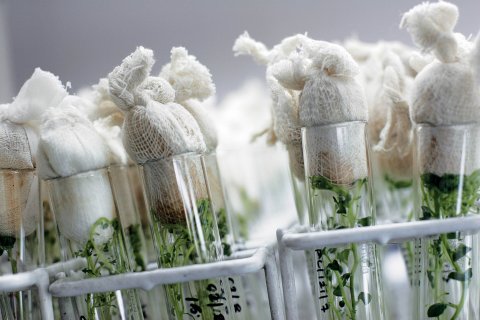
Anti-GMO activists tend to cite two scientific studies, which both involve rats, GM corn and the pesticide Roundup. Both were undertaken by French scientist Gilles-Éric Séralini and found that the rats fed the GM corn were more likely to die prematurely than a control group. But the journal that originally accepted the studies, Food and Chemical Toxicology, withdrew them, and every major scientific and food-safety organization in Europe has condemned them. Among the problems with the studies was that the strain of rats used in the test are cancer-prone—80 percent routinely develop tumors. "All we are seeing in these results is due to random variation in a poorly controlled experiment," Ian Musgrave, of the University of Adelaide, in South Australia, told Forbes when the studies were retracted.
Chances are, you've heard of Roundup (active ingredient: glyphosate). That's because it's the second in the supposed double punch that agrochemical company Monsanto has allegedly been throwing for years to create a cycle of financial dependence among farmers worldwide. Monsanto produces Roundup. Since 1996, it has also produced Roundup Ready crops, including soy, corn and alfalfa, all genetically modified to be resistant to the herbicide—which means it can be used on fields to get rid of encroaching plant life without harming the crops. That's great for farmers. But these Roundup Ready seeds have a dark side: farmers who buy them sign an agreement saying they will not save any seeds from the resulting crop. In other words, they have to buy new seeds every year from Monsanto. This has all been incredibly lucrative for the company; it currently has a third of the $40 billion global seed business. The Monsanto/Roundup controversy continues to inflame passions: Among the many concerns that have been raised is the possibility that genetically modified DNA from the Roundup Ready plants might be contaminating non-GMO food supplies. Then there's the fact that glyphosate might be a health hazard—the World Health Organization says it is a probable carcinogen.
Meanwhile, "No GMO" is now being embraced by consumer brands; the ascendant "fast-casual" chain Chipotle posts just such a sign in its restaurants. It makes sense: If over two-thirds of Americans think GMOs are unhealthy, declaring yourself GMO-free is a lucrative proposition. Local governments are also weighing in. Vermont now demands that all GMO foods sold there be labeled as such. Two rural counties in Oregon have banned GMO crops within their borders.

Yet despite the conventional wisdom, startup money for GMO development in the U.S. and elsewhere is flowing like it's coming out of a fire hose, first for biomedical applications, from venture capitalists as well as traditional pharmaceutical companies such as GlaxoSmithKline, Celgene and Novartis. U.S. startups include Caribou Biosciences, Editas, Intellia Therapeutics, CRISPR Therapeutics and CRISPR-Plant.
In China, where rural populations react to GMOs with dread and anger, the only genetically modified crop currently grown is Bittman's papaya. But China's mighty science establishment has thrown its weight behind genetic work, with 400 labs and 30,000 researchers. Labs there have already sequenced the genes of 3,000 varieties of rice, in preparation for matching them against one another to find the best traits for nutrition, yield and resistance to environmental stressors. One result someday soon will be what researchers have dubbed "green super rice." Even if the Chinese government can't sell genetically modified crops to its own people, there's a good chance the poor populations of Southeast Asia, Africa and India will welcome the nourishment. Gengyun Zhang, head of life sciences for BGI, China's giant state-sponsored genetic engineering center, recently said, "With today's technology, I have no doubt that we can feed the world."
Correction: This article originally incorrectly stated that today's world population is 2 billion. It is 7 billion. It also incorrectly suggested that "Bt" stands for "biotech." "Bt" actually stands for bacillus thuringiensis, a bacterium whose genes are often used in the development of genetically modified crops. It also incorrectly stated that Roundup Ready seeds are sterile.


